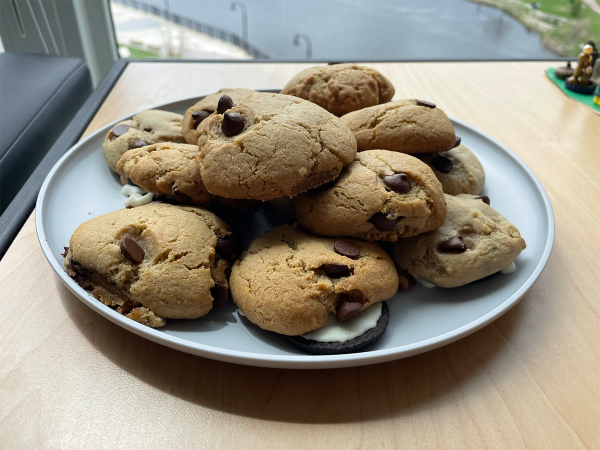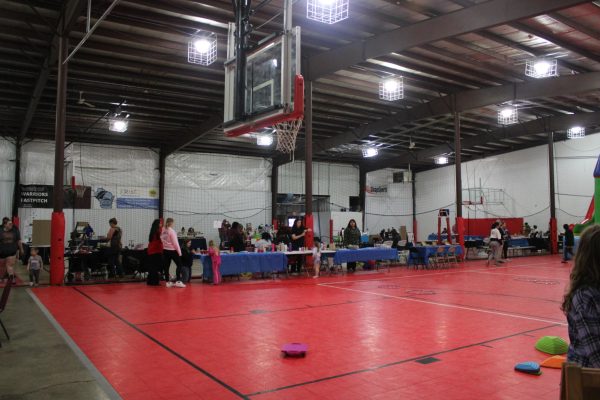Across the pond
Grub around the globe
Photo by Lea Kopke
Note: “Across the Pond” is an ongoing column in which two freelance writers will be writing about the difference in cultures they are discovering during their semesters abroad. Lea Kopke is studying in Marburg, Germany and Lauren Spierings in Valladolid, Spain.
Lea (Germany)
As I prepared to start school in Germany, I held some preconceived notions regarding what the food would be like. I expected hearty meals and not a lot of flavor. Unfortunately, I was correct in my prediction of a lack of spicy foods, but for the most part I’ve been surprised with the quality of foods available (minus their tendency to put corn and salami on pizza. That will never be okay).
A traditional German breakfast (Frühstück) consists of rolls served with butter, jam or a chocolate spread and a platter of various meats and cheeses. On a typical day, however, many students choose to eat Müsli, a cereal made of oats and whole grains mixed with various dried fruits and nuts. I have found Müsli to be the far superior version of granola, and typically eat it with milk or on top of my yogurt.
For many Germans, lunch (Mittagessen), is the most important — and largest — meal of the day. At my university, the main Mensa (student cafeteria) is only open for lunch and is a great example of a traditional German lunch. It serves various meat dishes, like burgers and sausages, along with one of endless different styles of potatoes. Most students, including myself, opt to instead go out to lunch at one of the many local restaurants or cook their own food back at their dorm or apartment. When I go out, I often eat Auflauf, which is the German version of casserole. Most restaurants in Marburg list at least a page or two of different varieties of Auflauf in their menus.
For dinner (Abendessen), German students tend to make or buy a much lighter meal. Almost a quarter of Marburg’s population is students, and 12 percent of them are international students, according to the university’s international office website. Because of this, the dorms are home to mostly international students. Each night I can smell a mixture of German, Korean, Pakistani and other types of food cooking in my floor’s shared kitchen. Many of my neighbors have been willing to share at least a bite of their dishes to teach others a bit more about their homes.One of the biggest differences I’ve noticed between cultures is the lack of fast food restaurants in Germany. Marburg has one McDonalds and one Subway, and that’s it. Luckily, finding a quick bite to eat remains a pretty easy task. The Germans have their own chain restaurant of sorts called Schwälmer-Brotladen. Rather than serving greasy food, SB serves bakery goods and sandwiches. I swear there’s one on every corner and in every train station.
The only type of business more widespread than Schwälmer Brotladen is döner shops. Döner is a turkish type of kebab that is cut into thin slices and typically served stuffed into pita bread with a mixture of vegetables and sauces. The dish was created in Berlin by a Turkish immigrant in 1972, and has since spread throughout Germany. It is the German student’s go-to late night meal — the shops see a lot of traffic once the bars start closing — and is definitely a contender in being the favorite food that I’ve tried.
Lauren (Spain)
Breakfast in Spain is sparse in the morning. It acts more like a snack until lunchtime than a meal, unlike what is practiced in the United States. A spanish breakfast (called desayuna) is typically a piece of toast, a piece of fruit or maybe a pastry. This is sometimes accompanied by a cup of coffee or some type of juice.
Lunch is the main meal of the day, similar to dinner in the United States. Called “la comida” in Spain and “almuerzo” in Latin and South America, Spanish lunch takes place later in the day, typically around 2-3 p.m.
This is a time to eat with the family and talk for an hour or two. It is somewhat common to be served lunch in courses, starting with a light soup or broth as a first course. The second course is something heavier, my experience being some form of meat like chicken or pork, or possibly fresh fish.
The meal finishes with a dessert of sorts. Sometimes this is fruit or something else light, others it will be something fancier like flan. After all of that food, Spaniards take a quick rest time called a “siesta” to digest a bit.
Dinner, called “cena” in Spanish, is fairly light as well. Sometimes it will just be a salad, or maybe some leftovers from lunch that day or the day before. Additionally, sometimes people eat yogurt or fruit to accompany the meal.
This may seem like a small amount of food in a day, but Spain also boasts somewhat of a coffee obsession. After siesta, many people will roam the streets or head into cafés to chat with friends for a few hours. During this time, they will sit down to eat and drink socially with others.
Spanish cuisine is not typically spicy or bland, instead it has a lot of fresh ingredients that give it flavor. Depending on which region of Spain the food is from, sometimes the food is very Mediterranean, others it has more ingredients from the countryside. All of it is fresh.
I currently live in Valladolid, which is a relatively small city in the Castile and León region of Spain. It isn’t near the ocean, so while my host family will sometimes cook fish it isn’t a frequent dish.
Just like Germany, there aren’t many fast food places here. There is a Burger King in Plaza Mayor and there is a McDonald’s roughly 20 minutes away from where I live, however those are the only fast food places I know of here.
In fact, it is rare to see any place to eat that isn’t a café or a bar. Instead, it is more common to see small shops that sell specific food types, like butchers (carnicerías), bakeries (panaderías), fish shops (pescaderías), and shops with fresh fruit and vegetables.
This is because it is very common to sit down and eat with your family instead of walking around while eating or eating with friends. There are few cafés that will hand you a coffee to go, instead you must sit and drink your coffee.
Spain is popular for a few dishes, like paella and the spanish omelette (tortilla española). These dishes can be found anywhere in Spain, however regional dishes like paella always taste the best when they are from their original regions.
One food I was very excited to try was morcilla. Also known as blood sausage, morcilla is typically made from pork blood. It is used as a topping or added ingredient to dishes. My host parents have made a soup of sorts that we mixed morcilla into afterwards, and I’ve also tried morcilla and scrambled eggs for dinner.
Kopke can be reached at [email protected].
Spieriengs can be reached at [email protected].

Lea Kopke is a fourth-year journalism and German student. This is her seventh semester on The Spectator staff. She plays the clarinet in the Blugold Marching Band and recently relearned how to ride a bike with no hands.

Timothy Spierings is a fourth-year Spanish and journalism student. This is their eighth semester on The Spectator staff. They enjoy trying all types of new foods and listening to new music artists and are currently trying to learn the bass guitar.











